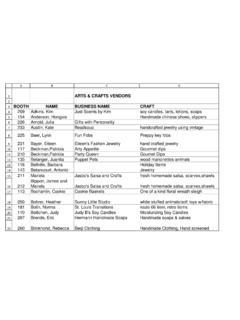Transcription of Canvas Painting 101 - LadyWeb
1 CanvasCanvasPaintingPainting101101 Canvas PaintingCanvas PaintingForForBeginnersBeginnersTable Of ContentsThis Complimentary EbookProvided ByTeresa Thomas BohannonTeresa Thomas BohannonAuthor of the OriginalRegency Romance NovelA Very Merry ChaseA Very Merry ChasePrepared for Distribution By LadyWeb 's Virtual Coffee Table Books All Rights Reserved Teresa Thomas Bohannon 2008 Table Of ContentsCanvas Painting 101!Beginners Guide To Canvas Painting Legal Notice:- The author and publisher of this Ebook and the accompanying materials have used their best efforts in preparing this Ebook. The author and publisher make no representation or warranties with respect to the accuracy, applicability, fitness, or completeness of the contents of this Ebook. The information contained in this Ebook is strictly for educational purposes. Therefore, if you wish to apply ideas contained in this Ebook, you are taking full responsibility for your author and publisher disclaim any warranties (express or implied), merchantability, or fitness for any particular purpose.
2 The author and publisher shall in no event be held liable to any party for any direct, indirect, punitive, special, incidental or other consequential damages arising directly or indirectly from any use of this material, which is provided as is , and without always, the advice of a competent legal, tax, accounting or other professional should be sought. The author and publisher do not warrant the performance, effectiveness or applicability of any sites listed or linked to in this Ebook. All links are for information purposes only and are not warranted for content, accuracy or any other implied or explicit Of ContentsTable of ContentsChapter 1 Painting 101 Chapter 2 Understanding PaintsChapter 3 Choosing Your BrushesChapter 4 Color Your WorldChapter 5 Light Sources in PaintingChapter 6 What type of painter are you?Chapter 7 Choosing A SubjectChapter 8 Setting Up Your StudioChapter 9 Art Supply ResourcesChapter 10 Clean Up TimeChapter 11 Free Art LessonsChapter 12 Take Care of Your CreationChapter 13 Pay Attention to DetailChapter 14 Enjoy Your SubjectChapter 15 Frequently Asked QuestionsChapter 16 Art SchoolsChapter 17 Museums of Fine ArtChapter 18 One Final Word Table Of ContentsChapter 1 Painting 101 People have been expressing themselves through Painting for thousands of years.
3 Even the cavemen showed great hunts or other events with paints made from berries and plants. There just seems to be an innate need to show others our thoughts, feelings, and ideas through pictures. The phrase A picture is worth a thousand words is so very colors and design you can express every emotion you feel. Whether it is a woman in a garden waiting for her lover or an old barn set in a field of wild flowers, the subject bring memories and feelings to the fore front of the viewer's mind. All of this being accomplished on a blank Canvas with are some basics the beginning artist should know. Although you may have been sketching and drawing for years, the first time you pick up a brush it will seem foreign to you. This is fine. You will become very familiar with each of the brushes and the strokes they can make. They will soon be as comfortable in your hand as the charcoal pencil you use on the sketch can add style and creativity to an art piece.
4 A single tear drop on the face can take on a totally new dimension by adding color. Paints allow you to do this with ease. The types of paint you use will also allow you to be more artists use the oil paints for extend projects. The oils do not dry as quickly and can be rejuvenated with a little turpentine or mineral spirits. This allows the artist to continue the project another day. The brushes you use with an oil Painting must be cleaned extremely well. If you allow them to sit in the cleaning solution they can loose their shape. This means you may not be able to use certain brushes to achieve a particular brush the artist uses acrylic paints, the dry time is extremely fast. Many times, a project which is being done in half an hour or so will be done with acrylic paints because of the ease of use. Clean up with soap and water is a quick task. The brushes wash up quickly and cleanly. Allowing them to dry either on a flat surface or standing with bristles up will keep their original best thing to do when first beginning Canvas Painting is to experiment.
5 Try using oils. Become familiar with acrylics. You will eventually choose which medium you prefer to work with. By playing with each, you can determine how the paints mix, get a feel for how they flow onto the Canvas , and become familiar with blending. These are all important for the novice artist to factor is the type of Canvas you will want to use. There are stretch canvases, rolled Canvas , Canvas boards, and Canvas mats. Each one can Table Of Contentsbe used for different styles, artwork, and even paints. Which one you use will be determined by which one you feel more comfortable Painting information can become overwhelming when you start Painting on Canvas . Getting to know the terminology will help clear some things up a little bit. Here are some terms we will be using in this abstract art depicts the subject by using form and color. You may see a resemblance to the original piece.
6 However, the subject is generally represented in more geometric shapes than the natural setting. Above are two forms of abstract Giving exceptional detail to a certain object in the Painting to bring attention to it. A good example of A type of paint which dries quickly. It can easily be cleaned up with mineral Prima Meaning at the first in Italian, this phrase means the Painting is completed with just one colors Colors associated with the cold such as Of ContentsColor Wheel Any full spectrum circular diagram which represents the relationships of colors. This allows the colors to be compared for The arrangement of the elements in an art The type of pain being used to create a work of art. It can also mean the binder, usually an The painter's board where colors can be mixed and and different hues can be created.
7 A before and after Being able to reproduce the same height, depth, and distance perception in a two dimensional medium that the human eye would perceive. This photograph is a good representation of The colored substance created by natural elements and synthetic ones which are mixed with certain binders to create colors A color which can not be created by mixing other colors. The only three primary colors are red, blue, and yellow. With these three all other colors can be created. (White is not a color. It is the absence of color. Black is the combination of all colors.) Secondary colors Any color which can be created from mixing the primary colors, such as violet, green, and colors Hues which represent warmth such as orange, red, that you know some of the language, let's step into the art Of ContentsChapter 2 Understanding PaintsThere are two types of paints which work well on Canvas .
8 One is oil and the other is acrylic. You need to choose which Painting medium you will be using. Some people prefer the oils to the acrylics. There are several differences between the two paints. The oil can take days to dry completely. This allows the artist to continue with the Painting for days after the original sitting. The acrylics are not so forgiving. These paints can dry within hours. If you think you can make a mistake and go back later to fix it, you are paints are made up of pigment and oils. A simple paint can be made from dried saffron and peanut oil. Mixed properly you can use this formula to create a wonderful shade of yellow which you could also eat. Most of the oil paints on the market are poisonous, so always keep them out of the hands of oil paints are made from three things. This is pigment, oil, and some type of drying agent. The latter was added because the oils took too long to dry.
9 Drying agents can be things like a paint the primary colors can be formulated into any other color in the spectrum, there is no need to try creating the same color every time you paint. Oil paints come in any shade or hue you can think of, from black to white. Each color can be blended with another to add even more combinations. There is literally no color you can not reproduce on the Canvas with oil paints. Oil paints can be used to create textures. They can be spread on thick or thin. One thing you will learn is the more thick you have the paint the longer it will take to dry. Also, a thick layer of oil paint will crack as it dries. This is not good for the Painting . The best thing to do when working with oils is to create the work in layers. This will allow the paint to dry evenly and prevent cracking. This is one reason why some artists spend days creating an art piece instead of rushing through alla are synthetic paints designed to mix and blend just like the oils.
10 The main difference is the dry time. While oils can take days, acrylics can take only hours. There are advantages to using acrylics over oils. When you need the project done quickly, the acrylics are up to the task. By Table Of Contentshaving a faster dry time, the Painting can have layers added in hours instead of days. With acrylics, the artist can be assured of a straight line for horizons or other needs. You can actually apply masking tape to dried acrylic paint. When you peel the tape off, there is no danger of lifting the paint off the Canvas . This ensures clean, precise lines every time. With oils, you would have to use an edger and still take the chance of smearing the artists prefer acrylics. Some prefer oils. There are those who go back and forth between the two, depending on the project. It is advisable to learn about each one. You should experiment with at least the primary colors to see which you prefer.







